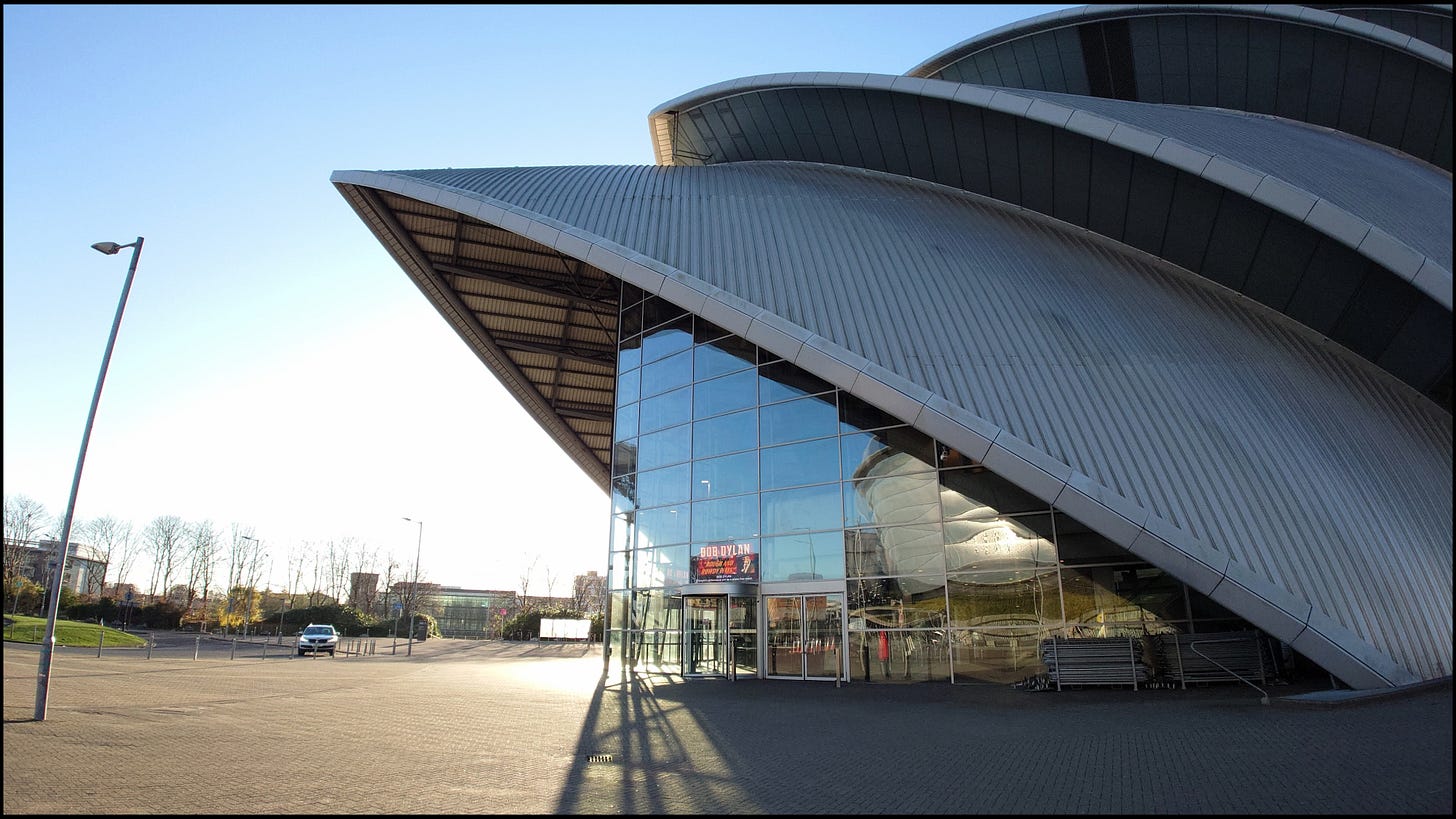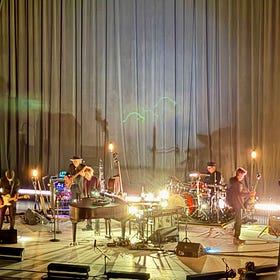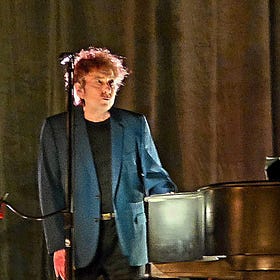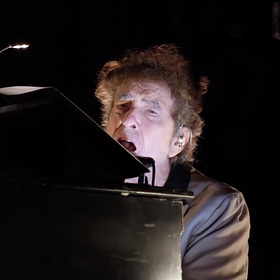Two Nights in Glasgow (by Angus Gibson)
2025-11-16/17, SEC Armadillo, Glasgow, Scotland
Flagging Down the Double E’s is an email newsletter exploring Bob Dylan concerts throughout history. Some installments are free, some are for paid subscribers only. Sign up here:

Bob Dylan just played two shows at Glasgow’s SEC Armadillo (from the photo above, I see where it gets its name), Sunday and Monday night. He has three more stops, all in Ireland, before his 2025 touring reaches its end.
Angus Gibson attended both nights in Glasgow and reports in, with both show reviews and a fascinating history of Dylan’s Glasgow appearances over the decades. Angus is managing editor at the excellent academic journal The Dylan Review, and writes on Substack at notes on pop music.
Here’s Angus:
Kurt Vile to Neil Young: “You went to outer space tonight!”.
Neil Young to Kurt Vile: “We can go there whenever we want.”
Bob Dylan leads a strange life. I can’t think of another human who has travelled as he has. For over 40 years, Dylan has visited the likes of London, Paris, Boston and Berlin almost every year. He must be deeply familiar with these cities, alongside his adopted hometowns of New York and Los Angeles.
That isn’t so unusual, but there are scores of places further from the beaten path that he also visits yearly, or at least every few years: Stockholm, Denver, Milan, Columbus, Brussels, Osaka. Then there’s the many hundreds of small towns he’s been to four or five times in recent decades: Syracuse, Cork, Spokane, Esch-sur-Alzette, Sioux Falls.
Who else is as intimately acquainted with all these towns – or at least parking lots and truck stops on the outskirts of these towns – as Bob Dylan?
Glasgow is one such place that Dylan must have memorised over the years. This week, Dylan is in town for his 20th and 21st show there since the Never Ending Tour rolled out of the traps in 1988. (He played one earlier show here in 1966).
Imagine you have an uncle who lives in Cleveland. You visit him every year during the holidays. After 20 years, you’d be pretty familiar with The Forest City (who knew that’s what locals call Cleveland?). This must be like Dylan’s relationship to Glasgow – and a hundred other towns.
Scientists say that memorising urban layouts is good for your brain. Famously, London taxi drivers have to pass ‘The Knowledge’ – a fiendishly hard test of London streets – to get a licence. According to researchers, these cabbies have bigger brains as a result of their daily routine navigating the city.
Perhaps it’s similar for Dylan. Maybe it’s his knowledge of a thousand small-town music venues – alongside his seemingly inexhaustible mind map of old songs – that’s responsible for his acute mental sharpness in his 85th year.
Dylan first explored Glasgow in 1966, during a visit captured by filmmaker D.A. Pennebaker in Eat The Document. You can watch Dylan tour the city’s tenements, admire bagpipers in George Square and, famously, record three songs – “On A Rainy Afternoon”, “I Can’t Leave Her Behind” and “If I Was A King” in a small bedroom in what is now the Millennium Hotel.
Today, rooms start at £104 per night. I recommend staying. It’s an affordable way to indulge your Dylan geekery. And I reckon there’s enough footage of the view from Dylan’s hotel window (seen in Mickey Jones’ World Tour 1966: The Home Movies) that it would be possible to locate the exact room our man slept in. Dear reader – I am geeky enough to have stayed there once, but not that geeky.
Back in 1966, Dylan played the Odeon Cinema on Renfield Street. The building is no longer a picturehouse, but its original art deco facade still stands – and is another worthy sightseeing stop.
Dylan’s regular trips to Glasgow continued apace from 1989. He played 10 shows between then and 2009, all at the Scottish Exhibition and Conference Centre (SECC) save for the famous Barrowland Ballroom club show in 2004.
The SECC is as dull as its name suggests – a big soulless metal shed. I once saw CSNY there and David Crosby apologised to the crowd for playing in an “aircraft hanger”. Dylan’s choice of venue didn’t improve when he finally moved to a new location in 2011, playing two nights with Mark Knopfler at Braehead Arena: an ice hockey rink connected to a shopping mall.
Those shows were most notable for the rumor that, between soundchecks, Dylan had bought a set of bagpipes from the city’s National Piping Centre. The Guardian reported that Dylan “purchased a set of RG Hardie pipes, along with a starter package that includes a practice chanter and beginner’s manual.”
Two years later, Dylan decamped to his current Glasgow venue, the SEC Armadillo, where he has remained ever since – playing three nights in November 2013, one night in 2017, and two nights in 2022.
The SEC Armadillo was originally called the Clyde Auditorium when it was built in 1997. But the metallic silver structure looks so much like an armadillo that its owners eventually relented and renamed it to its popular local nickname: The Armadillo.
It’s a much more refined venue than the SECC – a modern opera-style theatre with comfy seats, great acoustics and well thought-out sightlines. It’s much more intimate than it looks from the outside. It was a great fit for the theatrical set in 2013, and remains an excellent venue for the Rough and Rowdy Ways tour.
Night one: space travel
I walk into the hall and notice that Dylan’s baby grand piano is facing in the opposite direction compared to previous shows. This is not good news. I’ve spent the previous weeks studiously trading tickets to find one with perfect sightlines to our man, and this sudden move has thrown a spanner in the works.
If you haven’t attended a Dylan show this year, you may not be aware of Bob’s newfound nesting habits. He sits – rarely standing – behind his piano. A large black music stand on top of the baby grand holds pages of laminated lyric sheets that Dylan furiously turns between songs, providing a further screen to hide behind.
To one side of the piano is an electric keyboard that is left unplayed. A stool sits by Dylan’s knee, on which rests a cup, tissues, and an old miner’s lamp that casts shadows on the curtain behind the band.
As a result, you generally cannot see Dylan unless you’re in a very specific section on the house right side. This is where I am seated tonight, in the second row. Only now Dylan has turned the piano 180 degrees, so that all I can see is his tufty hair and occasional eyebrow, save for when he stands to take applause between songs.
At first this annoys me – as during “I’ll Be Your Baby Tonight”, a well executed opener that, unlike earlier nights in the tour, Dylan sings clearly and with gusto, playing piano throughout.
I spend the first three songs considering the ethics of the situation. I’ve paid roughly £150 to not see the act in question. I know, on a rational level, that I’m here to experience the music. It shouldn’t matter that I can’t see Bob’s eyes or mouth or chin. But on an emotional level, I feel like something’s missing; there is a barrier between me and the artist.
I am surprised at how quickly this annoyance fades. The music tonight is so good that I can’t help but fall into the groove. And, plus, I can see the band perfectly, and they’re all smiles.
The group kicks up a gear for “When I Paint My Masterpiece”, in the now customary “Istanbul (Not Constantinople)” arrangement. I think of this song as Dylan’s new single. Any other act, with a new instrumental this good, would have written new words and put in on an album. But Dylan, in his idiosyncratic way, has decided instead to repurpose the lyrics from an old 1971 rarity and play it for us live.
I’ve been waiting to hear the definitive version of this new arrangement, and tonight might be it. Dylan doesn’t play guitar, as he has done previously on this song, sticking to piano, which helps keep the performance tight and professional. His singing is perfect, drawing out the words with considered care.
The most exciting performance of the night is “My Own Version Of You”, which appears entirely improvised. Here’s Adam Selzer’s recollection of the performance (I can’t relay it any better than he already has):
The song began about as usual, in the stripped-down spoken word style that’s been standard since Royal Albert Hall a year ago. But early on, Dylan hit on a bass piano riff, sort of an oompah thing, and started to build a new melody around it. He’d sing a line, then play the same melody on piano, in a sort of call and response. Suddenly the song became a sort of sea shanty, like a crazed pirate captain, stalking the deck and whipping his zombie crew as they rowed.
It reminded me of Dr John’s Gris-Gris album, with the band improvising on a very heavy bass groove that Dylan bashed out on his piano. Bassist Tony Garnier and guitarist Bob Britt shared grins, as Bob took the song in new ever-more intrepid directions, occasionally laughing at his own audacity.
Expecting Rain user ‘yellowrailroad’ wrote: “It could fit nicely as a mid-album track on Tom Waits’ Bone Machine album.” I think that was intended as a criticism, but I agree wholeheartedly.
It’s in moments like this that you realise that Dylan’s band has the hardest job in music. They do far more listening than playing. No one is sitting back and strumming the chords – instead every note is a focused reaction to what Bob is creating. Maybe they’re the last great jazz quintet.
There’s an interview with Philadelphia rocker Kurt Vile, where he recalls an encounter with Neil Young after a Crazy Horse gig. Caught tongue-tied, all Vile can think to say is “you went to outer space tonight!” Young replies, deadly serious: “We can go there whenever we want.”
There are moments tonight – particularly on “My Own Version” and following track “To Be Alone With You” – where it felt like Dylan took the band to new soaring heights. It’s those euphoric moments that keep us coming back to Dylan. To quote Peter Perrett, “space travel’s in my blood, there ain’t nothin’ I can do about it.”
Later highlights included “It’s All Over Now, Baby Blue”, which Dylan sang with real tenderness. He sang the last verse twice, emphasising the melody.
“Mother of Muses” is now more muscular, with Bob Britt playing lap steel for the only time and Anton Fig providing a strong beat.
After the customarily beautiful closer, “Every Grain Of Sand”, I joined the long queue for the exit.
As the line approached the doors, an old head in his late sixties – probably disappointed that his hero didn’t play “Hurricane” – turned to face the stage and shouted: “If you’re still here Bob, that was out of order.” He gestured with his hands as if to emphasise the point: “OUT OF ORDER!”
I then heard two kids behind me, barely older than Bob was in 1961. One told the other: “I don’t see how you could complain about that, the music was just so good”. His friend replied: “It’s just as well that I’m really into the blues – I loved it. Though I could see why you might not if you don’t get the blues.”
I’m with the kids on this one.
Night two: What? Who?
Bob Dylan opts for the ‘rock star’ entrance tonight, letting the band walk out early to play a few bars before he strolls on to applause like James Brown or Elvis.
“I’ll Be Your Baby Tonight” is the usual opener. Unlike last night, the words aren’t sung clearly, but there’s a palpable sense that he’s quickly shaking off any tiredness. In recent shows, Dylan has needed three songs to warm up. It’s no different tonight, and by “I Contain Multitudes” it’s evident that the band are quickly moving into gear.
Halfway through the song Dylan pivots on his piano stool to face the drummer, singing while he emphasises the beat with his fist. It’s a similar scene to the now-infamous ‘wrenchgate’, but it’s clear Bob isn’t being critical, rather he’s visibly excited about the song’s new direction.
Drummer Anton Fig is the star of this tour, almost as much as Dylan and ever-present band leader Tony Garnier. His style lies somewhere between Charley Drayton’s light jazz touch, and George Receli’s New Orleans funk. It’s joyful to watch him embellish Dylan’s lyrics with the shake of Mardi Gras beads, softly-malleted cymbals and military tom fills. Many of the new arrangements in recent months owe much to Fig’s ability.
The fifth song, “When I Paint My Masterpiece” is another highlight. Where yesterday Dylan executed the arrangement perfectly, tonight he’s having fun creatively rearranging it. Most prominently, he adds new call-and-response lyrics so ridiculous he almost breaks out laughing:
Newspaper men eating what? Candy!
Had to be held down by who? Big police!
After last night, I am excited to discover what “My Own Version of You” will sound like. It starts with added New Orleans percussion, again leaning into the Gris-Gris / Bone Machine vibe, with Dylan’s intense vocal phrasing driving the song as only he can.
“My Own Version of You” has undergone a drastic evolution. In October and early November, it sounded like those Jack Kerouac and Steve Allen records, with Dylan spitting his lines like a beat poet over Fig’s free jazz improvisations. Now it’s fueled by the low notes on Dylan’s piano and Garnier’s stand-up bass. It’s much more forceful, and the most exciting song of the evening.
Dylan pumps out another heavy blues-based groove on “Watching The River Flow”. It’s real Deadhead music; the band noodle around the beat like Phil Lesh and Bob Weir might. I contemplate that we might have reached orbit once more.
“I’ve Made Up My Mind to Give Myself to You” is the standout of the second half. It too isn’t immune to Dylan’s creative itch. Like “Mother of Muses” last night, the slow ballad is injected with heavier drums and a bluesy rhythm. Bob Britt adds neat guitar lines, tonight playing a sunburst Stratocaster rather than the solid-body Gretsch that he’s played all tour. It’s one of the more memorable renditions I’ve heard on the Rough and Rowdy Ways tour.
Sometimes Dylan will hit an inflection point during a month-long tour leg. In Spring 2024, this happened in Nashville. There, the band found a magic energy that they sustained through Memphis, New Orleans, Lafayette and Dallas – culminating in the two great shows at Austin City Limits.
The recordings of those shows – particularly the second night – are my favourite of the entire Rough and Rowdy Ways tour. (I recently spent a late night in Brussels quizzing Nightly Moth and Sergi Fabregat Mata about the Austin gig. “What was it like to be there?”, “Were you in the front row?” I realised I was asking the same questions I used to ask older fans about their experiences in 1966 or 1975.)
I think this Glasgow residency will be a similar inflection point for this tour. Almost overnight, Dylan has hit upon a prolific creative streak and I’m very excited at what’s to come in Ireland. It’s shaping up to be his strongest run since those Austin shows.
He’s onto something new, finding unexplored avenues on his ever-expanding musical map. Hopefully – if God is willing and the creek don’t rise – Dylan’s long strange trip will lead him to Glasgow once more.
Angus Gibson is managing editor at The Dylan Review, and writes on Substack at notes on pop music.
2025-11-16, SEC Armadillo, Glasgow, Scotland
2025-11-17, SEC Armadillo, Glasgow, Scotland
Thanks to taper Bhoy for the quick turnaround recordings!
Catch up on other Fall 2025 Rough and Rowdy show reviews by more excellent guest writers:
Two Nights in Paris (by Matthew Ingate)
The first night of this year’s tour in Tulsa was the most recent, and maybe the best, R&RW show I’ve seen, and I felt, for the first time in a long time, a sense of trepidation going into the show in Paris because of it.
Last Night in Brighton (by Jack Walters)
At 84, Bob Dylan has lived a thousand lives and has worn more masks than a Venetian masquerade ball, putting the lecherous Byron to shame. And yet he is still on the road; his Coyote spirit alive. One gets the impression that…
Last Night in Coventry (by Adam Selzer)
One of the great pleasures of following Dylan is ending up in towns you’d never think to visit. I hadn’t been to Wales before at all, and if I had, I wouldn’t have thought to go to Swansea, a charming seaside town with…



